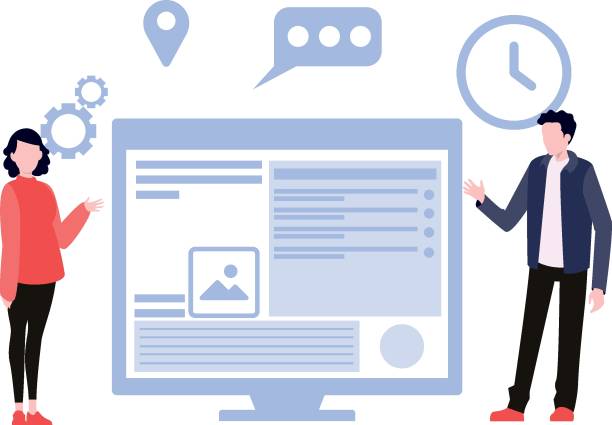An Introduction to the Importance of Modern User Interface Design

In today’s digital world, where the competition for user attention intensifies by the moment, #WebsiteDesign is no longer limited to merely displaying information.
#ModernUIWebsiteDesign and user experience (UX) have become the core of an online platform’s success.
A modern user interface is not only beautiful but also intuitive, accessible, and interactive.
This approach ensures that users can easily interact with the website, access the information they need, and enjoy a pleasant experience.
Neglecting these aspects can lead to high bounce rates and loss of audience.
Modern UI goes beyond colors and fonts; it is a design philosophy built on a deep understanding of user behavior and needs.
It is a vital element for any business that wants to be seen and grow in the online space.
Have you ever wondered why some websites immediately attract you while others repel you?
The answer often lies in the quality of their user interface design.
Websites that utilize modern design principles establish a stronger connection with their audience and encourage them to spend more time on the site.
This is not only important for businesses but also means a smoother and more efficient experience for users.
In this information age, where everyone is looking for an easy and fast way to access content, the importance of modern UI design is doubled.
A well-designed site can engrave your brand in the user’s mind.
Also, improving site SEO is an indirect result of an excellent user interface; Google ranks websites that offer a good user experience higher.
This is a positive cycle where good design helps attract more users and ultimately contributes to business growth.
Did you know that 85% of customers check your company’s website before any interaction?
With RasawWeb, build a corporate website worthy of your credibility.
✅ Increase credibility and customer trust
✅ Attract high-quality leads
⚡ Get free website design consultation
Fundamental Principles of Modern User Interface and User Experience Design

Modern UI design is built on key principles aimed at creating a seamless and engaging user experience.
One of the most important of these principles is simplicity and clarity.
A good UI should organize information in a way that allows the user to find what they need without confusion.
The appropriate use of white space, clear visual hierarchy, and intuitive navigation all contribute to this simplicity.
Responsiveness is another crucial principle in today’s world.
Given the variety of devices, from mobile phones to desktops, a modern website must be able to seamlessly adapt its functionality and appearance to any screen size.
This means responsive design, which maintains a consistent and efficient user experience regardless of the device.
Consistency and stability are also of high importance.
Design elements such as buttons, forms, and fonts should be consistent throughout the website so that the user is not confused and can easily learn interaction patterns.
Visual feedback is also an element often overlooked but very important.
Users need to know the outcome of their actions; for example, a button that changes color after being clicked provides positive feedback to the user.
These feedbacks assure the user that the system is processing their request and prevent unreasonable expectations.
Accessibility is also a core principle that ensures the website is usable by all users, including those with special needs or disabilities.
This includes using alternative text for images, appropriate color contrast, and keyboard navigation capabilities.
Integrating these principles into every modern UI website design project not only leads to an improved user experience but also significantly helps increase the website’s credibility and reach.
A modern design means a deep understanding of user psychology and applying it to every aspect of interaction.
For a website to truly stand out, it must not only adhere to these principles but integrate them into the very fabric of its design.
Leading Tools and Technologies in Modern UI Website Design
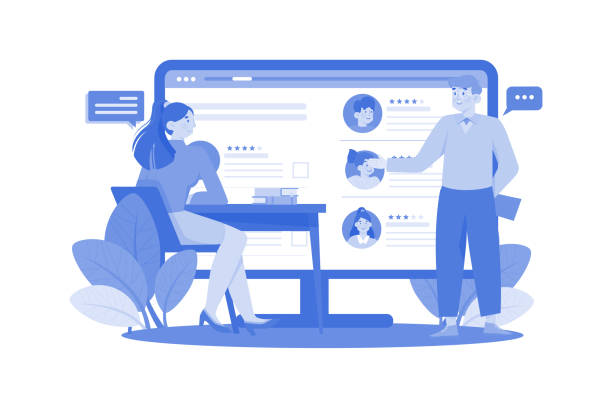
To implement a modern UI website design, designers and developers need a set of advanced tools and technologies.
These tools help them turn their designs into reality and deliver a flawless user experience.
Design tools such as Figma, Adobe XD, and Sketch allow designers to create interactive prototypes and wireframes, facilitate collaboration with teams, and receive necessary feedback from clients.
These tools, with features like vector-based design, component libraries, and teamwork capabilities, accelerate the design process and enhance the quality of the output.
Alongside design tools, front-end technologies also play a vital role.
HTML5 and CSS3 are the backbone of any website, providing extensive capabilities for implementing beautiful and interactive user interfaces.
Using CSS frameworks like Bootstrap or Tailwind CSS helps developers implement responsive design more quickly.
These frameworks simplify the development process by offering ready-made components and a grid system.
JavaScript and its frameworks like React, Vue.js, and Angular play a key role in creating dynamic and interactive user interfaces.
These frameworks enable the creation of Single-Page Applications (SPA) that provide users with a desktop application-like experience and minimize page loading.
For content management, Content Management Systems (CMS) such as WordPress, Joomla, or Drupal have maintained their popularity.
These systems, especially WordPress, offer extensive possibilities for customizing and developing modern UI websites with diverse plugins and themes.
Finally, performance testing and optimization tools like Google Lighthouse or PageSpeed Insights help developers optimize websites in terms of speed, accessibility, and SEO best practices.
Below is a table of commonly used tools in modern UI design:
| Category | Tool/Technology | Main Use |
|---|---|---|
| UI/UX Design Tools | Figma | UI design, prototyping, team collaboration |
| UI/UX Design Tools | Adobe XD | Wireframing, prototyping, user experience design |
| Front-end Frameworks | React.js | Building dynamic and component-based user interfaces |
| Front-end Frameworks | Vue.js | Developing advanced and interactive user interfaces |
| CSS Frameworks | Bootstrap | Responsive and fast website design |
| Content Management Systems | WordPress | Building and managing websites with extensive features |
The Impact of Modern UI on User Interaction and Loyalty
![]()
Modern UI website design is more than just an attractive appearance; it’s a powerful factor in shaping user interaction and fostering their loyalty.
When a user lands on a website with an intuitive, fast, and responsive user interface, they gain a positive experience that directly impacts the time they spend on the site, the number of pages viewed, and their likelihood of returning.
A poor UI can quickly discourage a user and push them towards competitors.
However, a well-designed, modern UI simplifies navigation and encourages users to explore more content and engage further with the site’s features.
This positive experience, in turn, helps increase the Conversion Rate, whether that conversion is purchasing a product, filling out a form, or subscribing to a newsletter.
User loyalty is also closely linked to the user experience.
Users who have a smooth and frictionless experience are more likely to return to your website and recommend it to others.
This is particularly crucial for businesses looking to build a strong community or a loyal customer base.
Thought-provoking content can also be cleverly integrated into a modern UI to make users think and spark discussion and interaction.
For example, interactive surveys, quizzes, or small games related to the content can significantly boost engagement rates.
Have you ever wondered how a website can become a loyal friend to a user?
This happens when the website anticipates user needs, provides quick responses, and delivers a consistently enjoyable user experience.
This requires a deep understanding of user psychology and the continuous application of modern user experience design principles.
Websites today have transformed beyond mere storefronts; they are platforms for communication, learning, and entertainment, and a modern UI is key to achieving these goals.
Do you dream of a thriving online store but don’t know where to start?
RasawWeb is your comprehensive e-commerce website design solution.
✅ Attractive and user-friendly design
✅ Increase sales and revenue⚡ Get free consultation now
Responsive Design and the Mobile-First Approach in the Modern Web World

In the current era, where mobile device usage for internet access has surpassed desktops, modern UI website design would be incomplete without a Responsive Design and Mobile-First approach.
Responsive design means building a website that can automatically adjust its appearance and functionality to the screen size of the user’s device.
This implies that a website should display and operate correctly on both a small smartphone and a large monitor.
This approach ensures that all users, regardless of the device they use, have an optimal user experience.
The mobile-first approach goes even further.
In this methodology, designers first design and develop the mobile version of the website and then progressively enhance it for larger devices such as tablets and desktops.
This approach helps designers focus on essential content and features, preventing clutter and information overload on mobile versions.
This not only aids in faster website loading on mobile devices but also leads to a simpler and more focused user experience.
Google has also increasingly emphasized the mobile-first approach, considering it an important factor in ranking websites in search results.
Therefore, websites that are not properly optimized for mobile might fall behind in competition with more modern sites.
This is crucial news for any business that wants to succeed in the online space.
Developers should use CSS frameworks like Bootstrap or Flexbox and Grid Layout in CSS to effectively implement responsive designs.
Also, images and videos must be optimized to display well on different devices and not reduce loading speed.
Ultimately, a website properly optimized for mobile not only enhances the user experience but also increases business potential.
This is an essential guide for anyone planning to design a website in today’s world and wants their website to remain relevant and efficient over time.
Integrating Accessibility in Modern UI Designs

One of the key and often overlooked aspects of modern UI website design is Accessibility.
Accessibility means ensuring that your website or application is usable by all individuals, including those with visual, auditory, motor, or cognitive disabilities.
Ignoring this aspect is not only ethically questionable but can also lead to the loss of a large portion of the audience and business opportunities.
An accessible website allows users to access and interact with content using assistive technologies such as Screen Readers, keyboards, or voice recognition software.
Accessible design principles include using appropriate color contrast for text and background, providing alternative text (alt text) for images, using semantic and organized HTML structure, and ensuring full keyboard navigation capability.
For example, for a visually impaired user using a screen reader, alt text for images is crucial to understand visual content.
Also, ensuring that all interactive elements like buttons and links have clear and accessible descriptions is vital.
This topic is a specialization in web design that requires technical knowledge and a deep understanding of the needs of different users.
Organizations like the World Wide Web Consortium (W3C) and the Web Accessibility Initiative (WAI) have published Web Content Accessibility Guidelines (WCAG) that provide a comprehensive guide for designers and developers.
Adhering to these standards not only helps you create a more inclusive website but can also improve your website’s SEO, as search engines prefer accessible websites.
Accessibility integration should occur from the very initial stages of design and should not be considered a post-completion phase of the project.
An accessible design means a smart and inclusive design that enhances the user experience for everyone.
This is an educational approach that helps designers learn the best practices for creating websites that are usable by all.
Future Trends and Innovations in User Interface and User Experience Design

The world of modern UI website design is constantly evolving, and every year we witness new innovations and trends that elevate the user experience to higher levels.
One of the most important future trends is the increasing use of Artificial Intelligence (AI) and Machine Learning (ML) in personalizing the user experience.
AI can analyze user behavior and dynamically optimize content, recommendations, and even the user interface for each individual user.
This deep personalization significantly boosts user engagement and satisfaction.
Augmented Reality (AR) and Virtual Reality (VR) are also finding their place in web design.
Although still in early stages, their potential to create immersive and entertaining experiences on websites, especially in e-commerce, education, and gaming, is very high.
Imagine being able to view a product in 3D space or experience a training course in a virtual environment; these are all part of the future of the web.
Voice User Interface (VUI) design is also gaining more importance with the increasing popularity of voice assistants like Siri, Alexa, and Google Assistant.
Designing websites for voice interaction creates new challenges and opportunities for designers.
This is particularly vital for improving accessibility for individuals who may not be able to use visual interfaces.
Serverless Architecture and Micro-frontends are also changing how websites are built.
These approaches enable faster development, better scalability, and easier maintenance, ultimately leading to improved performance and user experience.
Finally, sustainability and green design are also becoming a significant trend.
Designers are seeking solutions that reduce website energy consumption and act more environmentally responsibly.
This is an analysis of the future that shows websites are moving towards greater intelligence, interactivity, and inclusivity.
The table below shows some emerging trends in UI/UX design:
| Emerging Trend | Description | Impact on User Experience |
|---|---|---|
| Artificial Intelligence (AI) in UI/UX | Personalizing content and experience based on user behavior | Increased engagement and satisfaction, anticipating user needs |
| Augmented Reality (AR) and Virtual Reality (VR) | Creating 3D and immersive web experiences | Entertaining and realistic experiences, improved product understanding |
| Voice User Interfaces (VUI) | Interacting with websites through voice commands | Increased accessibility, hands-free ease of use |
| Micro-interactions Design | Small animations and feedback to enhance interactions | More enjoyable user experience, helps understand system status |
Successful Examples of Modern UI Website Design
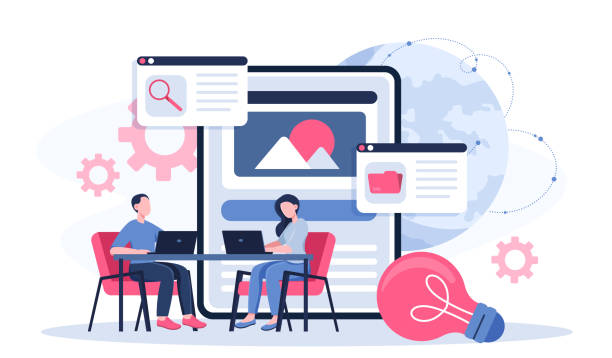
To gain a deeper understanding of the importance of modern UI website design, examining successful examples can be highly inspiring.
Websites like Airbnb, Spotify, and Netflix are all prominent examples of platforms that have achieved remarkable success by focusing on a flawless user experience.
These websites are not only visually appealing but have also transformed complex processes into simple and intuitive experiences.
Airbnb, with its clean and intuitive user interface, has simplified the process of finding and booking accommodation for users worldwide.
High-quality photos, advanced search filters, and a smooth reservation system have all contributed to an outstanding user experience.
This platform demonstrates how modern design can help users achieve their goals while also being enjoyable.
Spotify is another example of a successful user interface that has attracted millions of users with personalized music and easy navigation.
Dark design, clear typography, and smart music recommendations, all led to a deep and engaging user experience that encourages users to listen to music for hours.
This site clearly shows how a design can be both entertaining and highly functional.
Netflix, with its advanced algorithms for content recommendation and an efficient user interface for watching movies and series, has set new standards in the streaming industry.
Seamless viewing experience, easy access to movie information, and the ability to create multiple profiles have all contributed to high user loyalty.
These cases demonstrate how good design can make complex content manageable and accessible.
The common lesson from these examples is that modern UI website design must pay attention to both visual aesthetics and functional performance.
These websites not only look good but also help users solve their problems, entertain them, and provide an unforgettable experience.
They are platforms that grow with the needs of their users and are constantly innovating to deliver the best possible experience.
Are you dissatisfied with your e-commerce site’s low sales?
RasawWeb is your solution for having a professional and high-selling e-commerce website.
✅ Significant increase in sales and revenue
✅ Easy and enjoyable shopping experience for customers
⚡ Get free consultation from RasawWeb right now!
Common Mistakes in UI Design and Ways to Avoid Them
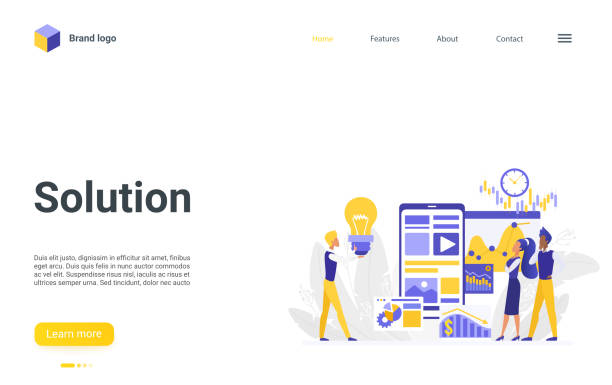
In the journey of modern UI website design, there are common mistakes that can severely impact the user experience and even lead to a project’s failure.
Recognizing these mistakes and knowing how to avoid them is crucial for every designer and developer.
One of the biggest mistakes is neglecting the real needs of the user.
Sometimes designers operate based on their own assumptions, relying on guesswork instead of research and testing.
This can result in a UI that looks beautiful but is not effective for the target users.
The solution is to always start the design process with user research and use feedback to validate your assumptions.
Over-complication in design is also a common trap.
In an attempt to offer many features, some websites become too cluttered, making navigation difficult.
A modern UI should prioritize simplicity.
Instead of adding every possible feature, focus on core functionalities and ensure that each element has a clear purpose and is easily understandable.
Lack of consistency and uniformity in design can also lead to user confusion.
Sudden changes in font style, colors, or button behavior across different pages disrupt the user experience.
Utilizing Design Systems and component libraries can help maintain consistency throughout the project.
Ignoring accessibility is also a major mistake, as mentioned earlier.
Designing a website without considering the needs of users with disabilities is not only ethically wrong but can also be legally problematic.
Ensuring website compliance with WCAG standards should be considered from the outset.
Finally, not optimizing for speed and performance can also drive users away.
No one likes a website that loads slowly.
Optimizing images, using caching, and minimizing unnecessary code all contribute to improved speed.
By avoiding these common professional mistakes, the quality of website UI design can be significantly enhanced, and a better user experience can be provided.
This is a practical guide for designers to prevent potential challenges.
The Continuous Future of Modern UI Website Design
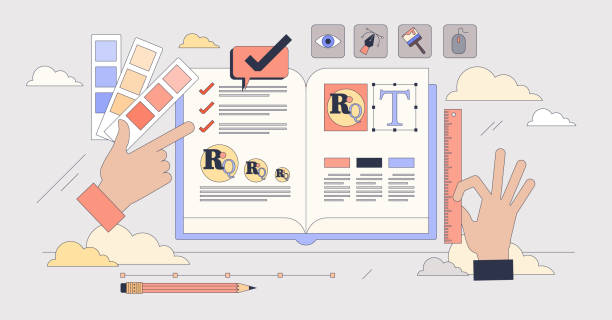
Modern UI website design is not a static field; rather, it is a continuous evolutionary process that is constantly redefining and improving with technological advancements and changing user needs.
What is considered modern today might be obsolete tomorrow, and this dynamism forces designers and developers to always be learning and updating their knowledge.
The importance of modern UI website design will not diminish in the future; instead, its role will become more prominent with the increasing interaction between humans and machines.
With the advent of technologies such as Brain-Computer Interfaces (BCI) and eXtended Realities (XR), the concept of “user interface” can take on entirely new dimensions.
These developments raise thought-provoking questions about the nature of our interaction with digital devices and the boundaries between physical and digital reality.
Will we need screens in the future, or will our interactions be entirely based on gestures, thoughts, and voice?
The main challenge in this path is to maintain the simplicity and intuitiveness of the user experience, even with the increasing complexity of underlying technologies.
Designers must be able to integrate these advanced technologies in such a way that users don’t even notice their presence and have a completely natural and frictionless experience.
Responsibility in design will also become increasingly important; this includes ethical design, user privacy protection, and creating inclusive experiences for all individuals.
Websites must not only be efficient but also respect human values and prevent potential negative impacts.
Continuous analysis of user data, conducting A/B tests, and listening to feedback are among the actions that help designers keep pace with these changes and continuously improve their designs.
Ultimately, the future of modern UI website design is tied to deeper interaction, greater intelligence, and more personalized and inclusive experiences for every user.
This is an endless journey toward optimization and innovation that illuminates new aspects of human interaction every day.
Frequently Asked Questions
| Question | Answer |
|---|---|
| What is modern UI website design? | It is an approach to website design that focuses on clean aesthetics, simplicity, high usability, and delivering an intuitive and pleasant user experience (UX). |
| What are the key elements of a modern web user interface? | Flat Design, smart use of white space, attractive typography, intuitive navigation, high-quality images, and responsiveness are among the main elements. |
| Why is using a modern UI important in website design? | It attracts and retains users, increases brand credibility, improves conversion rates, and provides a smooth and pleasant user experience. |
| What impact does a modern User Interface (UI) have on User Experience (UX)? | A modern UI directly improves the user experience by creating a beautiful, organized, and understandable environment, making interaction easier. |
| What is the role of typography in modern UI design? | Typography is crucial for readability, establishing information hierarchy, conveying brand mood and feel, and the overall visual beauty of the site. |
| How does Responsive Design relate to modern UI? | Responsive design is an integral part of modern UI, as it ensures that the site’s appearance and functionality are consistent and optimal across all devices (mobile, tablet, desktop). |
| What are the current trends in modern web UI design? | Dark Mode, subtle animations, creative use of white space, prominent typography, and the use of asymmetrical graphic elements are among recent trends. |
| How can one ensure that a modern UI has high Usability? | By conducting user testing, simplifying navigation, providing clear Calls to Action (CTAs), improving loading speed, and paying attention to Accessibility. |
| What is the main difference between UI and UX in modern design? | UI is the look and feel of the site (user interface), while UX is the overall experience of the user when interacting with the site. UI is considered a part of UX. |
| What tools are used for modern web UI design? | Common tools like Figma, Sketch, Adobe XD, Photoshop, and Illustrator are used for designing and prototyping modern user interfaces. |
And other services of RasawWeb Advertising Agency in the field of advertising
Smart Conversion Rate Optimization: A fast and efficient solution for campaign management focusing on attractive UI design.
Smart SEO: A combination of creativity and technology to increase sales through user experience customization.
Smart Customer Journey Map: A combination of creativity and technology for campaign management through custom programming.
Smart Advertising Campaign: An effective tool for online growth with the help of intelligent data analysis.
Smart Customer Journey Map: A fast and efficient solution for improving SEO ranking focusing on Google Ads management.
And over a hundred other services in the field of internet advertising, advertising consultation, and organizational solutions
Internet Advertising | Advertising Strategy | Advertorials
Resources
What is Modern Web Design?
The Future of Web and AI
UI/UX Design Principles
Web Development Trends in 2024
? For your business to reach its peak in the digital world and have a powerful and influential presence, Rasawweb Afarin Digital Marketing Agency, with expertise in key areas such as user-friendly website design, Search Engine Optimization (SEO), and targeted advertising campaigns, paves the way for your growth.
📍 Tehran, Mirdamad Street, next to Bank Markazi, Kazeroon Jonoubi Alley, Ramin Alley, No. 6

